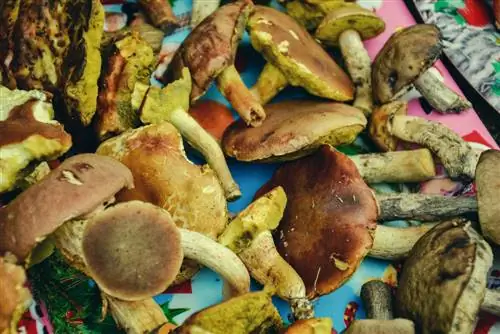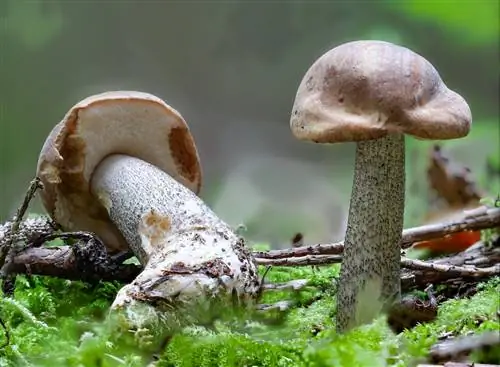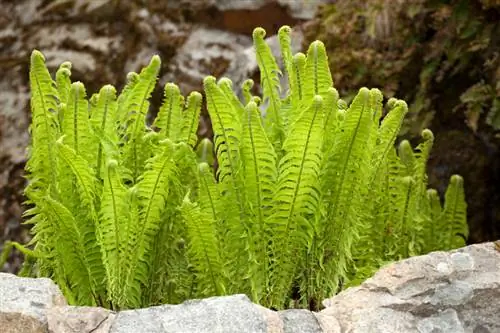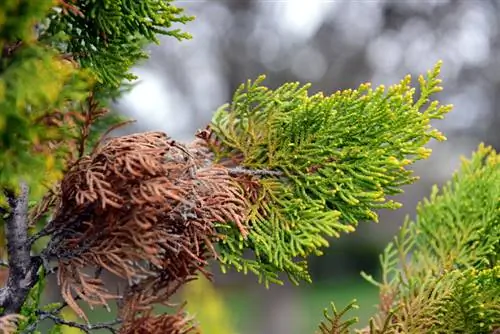- Author admin [email protected].
- Public 2023-12-25 17:45.
- Last modified 2025-01-23 11:21.
There is great enthusiasm during a walk in the forest: there are numerous porcini mushrooms in a mossy clearing covered in spruce trees. However, when you cut it off, your joy is dampened because the interfaces turn blue. Is it a poisonous doppelganger?
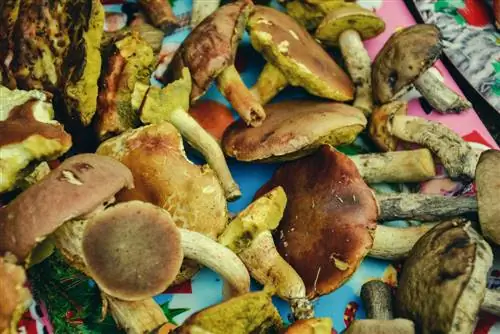
At a glance Why does the porcini mushroom turn blue? Mushrooms that turn blue when cut or when pressure is applied to the tubes are not porcini mushrooms. Instead, it is most likely the chestnut boletus, which is also edible. The blue color is created by the conversion of yellow dyes into blue ones through the action of oxygen
Porcini mushrooms do not change color
In fact, porcini mushrooms do not change color when cut or when pressure is applied to the whitish to yellowish-green tubes. On the other hand, if tubes and interfaces turn blue immediately when touched, it is most likely the chestnut boletus, which is also edible and very similar to the porcini mushroom. The blue color reaction comes from the conversion of yellow dyes into blue through exposure to atmospheric oxygen. You can also find the same reaction with the flake-stemmed witch's boletus and the red-footed boletus, both of which are also edible.
Chestnut Boletus
The chestnut boletus is common in deciduous forests, especially in coniferous forests under spruces. It is often accompanied by wild blueberries. In contrast to the finely moistened stem of the porcini mushroom, that of the chestnut boletus has brownish longitudinal fibers. But be careful: This mushroom stores toxic heavy metals such as radioactive cesium in its brown cap skin. You should therefore not eat the mushroom too often, especially in southern Germany.
Flake-stemmed witch's boletus
Through its name and the typical red-colored tubes, this mushroom signals that it is toxic, but it is not. Instead, it is an excellent edible mushroom that is even superior to the porcini mushroom in some respects: the flake-stemmed witch's boletus is rarely attacked by maggots. Similar to the porcini mushroom, it prefers beech and spruce trees, but grows almost exclusively on barren, sandy soil. Mosses and blueberry weeds are sure indicators of such soil conditions.
Red-footed boletus
The red-footed boletus is a tasty mushroom that can be found in abundance in many deciduous forests until late autumn. However, you should only take young specimens with you, as the older ones are often infected with the poisonous golden mold. You can recognize the infestation because the yellow tubes or the hat are covered by a velvety, whitish to yellow layer of mold.
Danger of confusion with the gall bolete
The gall boletus, which is not poisonous but very bitter, is also very similar to the porcini mushroom. The porcini mushroom has a whitish net, especially at the top of the stem, and the gall boletus has a brown one. If in doubt, you can carefully cut the mushroom you have found with a knife and lick it once with your tongue: the non-poisonous gall boletus lives up to its name - it tastes bitter!
Tip
When collecting mushrooms, remember that you are only allowed to take small quantities from the forest for your own use.

